deployment of the PLA Navy ships in the - Information Resource ...
deployment of the PLA Navy ships in the - Information Resource ...
deployment of the PLA Navy ships in the - Information Resource ...
Create successful ePaper yourself
Turn your PDF publications into a flip-book with our unique Google optimized e-Paper software.
FFFFFFFFFFFFFFFFFFF<br />
Vulnerability Analysis <strong>of</strong> Second Strike<br />
Based on <strong>the</strong> factors considered above <strong>the</strong><br />
vulnerability analysis <strong>of</strong> <strong>the</strong> three Vectors has been<br />
carried out <strong>in</strong> <strong>the</strong> succeed<strong>in</strong>g paragraphs. To narrow<br />
down <strong>the</strong> scope <strong>of</strong> <strong>the</strong> analysis, <strong>the</strong> author has<br />
assumed that <strong>the</strong> First Strike force to be Ch<strong>in</strong>a/<br />
Pakistan and <strong>the</strong> Second Strike force to be India.<br />
Though Ch<strong>in</strong>a has also declared a NFU policy,<br />
however, it is not applicable aga<strong>in</strong>st countries with<br />
territorial disputes and hence is considered as a First<br />
Strike force. A table <strong>of</strong> known nuclear arsenal <strong>of</strong> Ch<strong>in</strong>a,<br />
Pakistan and India as published by Mr Robert S Norris<br />
<strong>of</strong> <strong>the</strong> Natural <strong>Resource</strong>s Defense Council <strong>of</strong> USA and<br />
Mr Hans M Kristensen <strong>of</strong> <strong>the</strong> Federation <strong>of</strong> American<br />
Scientists is placed at <strong>the</strong> end <strong>of</strong> <strong>the</strong> paper for reference.<br />
• Deception. Land and Air vectors per<br />
force have to be located with<strong>in</strong> <strong>the</strong> ma<strong>in</strong>land<br />
due non availability <strong>of</strong> defence pact with any<br />
o<strong>the</strong>r nation. Position<strong>in</strong>g <strong>the</strong>se vectors on<br />
islands is likely to ease identification problems for<br />
<strong>the</strong> enemy. Therefore it can be fairly assumed<br />
that consider<strong>in</strong>g <strong>the</strong> elaborate <strong>in</strong>telligence<br />
network and <strong>the</strong> technology available, <strong>the</strong><br />
primary and some <strong>of</strong> <strong>the</strong> alternate locations <strong>of</strong><br />
our strategic assets on land would be known to<br />
<strong>the</strong> enemy. However, Sea vectors compris<strong>in</strong>g<br />
surface <strong>ships</strong> and submar<strong>in</strong>es could be put to<br />
sea. Ships at sea are free to manoeuvre <strong>in</strong><br />
<strong>in</strong>ternational waters and hence identification<br />
and subsequent target<strong>in</strong>g would be difficult.<br />
Submar<strong>in</strong>es due to <strong>the</strong>ir <strong>in</strong>herent characteristic<br />
<strong>of</strong> operations are <strong>the</strong> stealthiest and would be<br />
<strong>the</strong> most difficult to neutralise.<br />
• Mobility.<br />
• Land Vectors. Land vectors with<strong>in</strong><br />
weapon range are limited by <strong>the</strong>ir speed<br />
and restricted by availability <strong>of</strong> road/ rail<br />
network. Moreover, consider<strong>in</strong>g <strong>the</strong> large<br />
area <strong>of</strong> dispersion <strong>of</strong> WMD, Land vectors<br />
may not be able to escape once <strong>the</strong> First<br />
Strike has been launched. Hence unless<br />
pre-positioned beyond adversary's<br />
weapon range, <strong>the</strong> redundancy may not<br />
be significant. These far out surviv<strong>in</strong>g units<br />
would <strong>the</strong>n take a f<strong>in</strong>ite amount to close<br />
distance to enemy land to launch <strong>the</strong><br />
FFFFFFFFF<br />
SEPTEMBER 2010<br />
Second Strike weapons which may not be<br />
acceptable. This could be overcome by<br />
hav<strong>in</strong>g longer range weapons with <strong>the</strong><br />
Second Strike force.<br />
• Air Vectors. Air vectors on <strong>the</strong> o<strong>the</strong>r<br />
hand enjoy .<strong>the</strong> highest mobility, however,<br />
would rema<strong>in</strong> limited to territorial limits<br />
unless Carrier based. Movement <strong>of</strong> land<br />
based Air vectors are subject to various<br />
enemy <strong>in</strong>telligence ga<strong>the</strong>r<strong>in</strong>g sources at<br />
<strong>the</strong> primary/ alternate air bases, hence<br />
could be compromised and targeted.<br />
Moreover, <strong>the</strong> effect <strong>of</strong> wide area<br />
dispersion <strong>of</strong> WMD on <strong>the</strong>se vectors on<br />
ground would be similar to Land vectors.<br />
• Sea Vectors. Sea based surface<br />
vectors have <strong>the</strong> freedom <strong>of</strong><br />
maneuverability <strong>in</strong> <strong>in</strong>ternational waters<br />
keep<strong>in</strong>g beyond range <strong>of</strong> enemy<br />
weapons. These vectors could be<br />
deployed well <strong>in</strong> advance and could<br />
launch <strong>the</strong>ir long range nuclear weapons<br />
or move <strong>in</strong> to deliver <strong>the</strong> shorter range<br />
weapons. Conventional submar<strong>in</strong>es<br />
though limited by speed could be prepositioned<br />
<strong>in</strong> <strong>in</strong>ternational waters close to<br />
adversary's shore thus enabl<strong>in</strong>g delivery<br />
<strong>of</strong> even short range weapons. On <strong>the</strong><br />
o<strong>the</strong>r hand SSBNs would have <strong>the</strong><br />
comb<strong>in</strong>ed advantage <strong>of</strong> speed and stealth<br />
provided by <strong>ships</strong> and conventional<br />
submar<strong>in</strong>es respectively. Fur<strong>the</strong>r <strong>the</strong><br />
effects <strong>of</strong> WMD at sea are not as grave as<br />
on land due atmospheric conditions and<br />
absence <strong>of</strong> collateral damage.<br />
• Range. Ch<strong>in</strong>a has tested ballistic missiles<br />
which could cover <strong>the</strong> entire Indian ma<strong>in</strong>land.<br />
Pakistan on <strong>the</strong> o<strong>the</strong>r hand has ballistic missiles<br />
that could cover most <strong>of</strong> North, West and Central<br />
India. Moreover, Ch<strong>in</strong>a presently and Pakistan<br />
<strong>in</strong> future could have sea based vectors <strong>in</strong>clud<strong>in</strong>g<br />
<strong>ships</strong> enabl<strong>in</strong>g <strong>the</strong>m to target strategic assets <strong>in</strong><br />
south India and <strong>the</strong> littorals. Hence, <strong>in</strong> case <strong>of</strong> a<br />
First Strike, target<strong>in</strong>g land and air vectors could<br />
be effective ensur<strong>in</strong>g deterioration <strong>in</strong> <strong>the</strong><br />
Second Strike capability. Whereas for <strong>the</strong> Second<br />
FFFFFFFFF 36



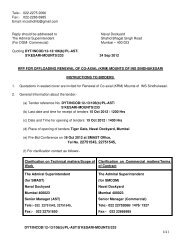

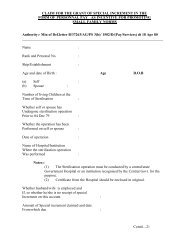
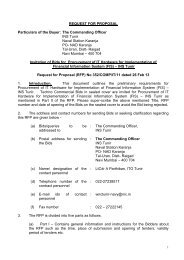
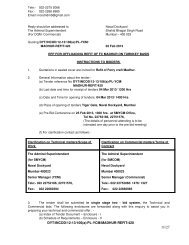
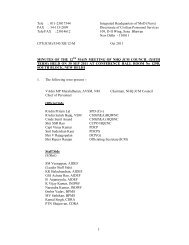

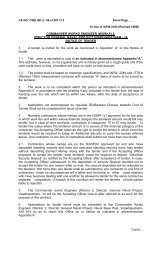
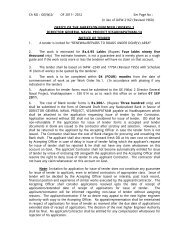
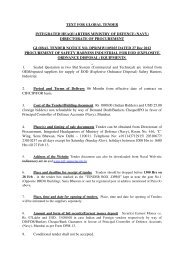
![DGNP[V] - Irfc-nausena.nic.in](https://img.yumpu.com/23509938/1/158x260/dgnpv-irfc-nausenanicin.jpg?quality=85)



